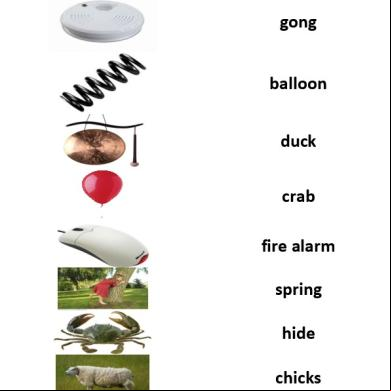27 Mineral Oil Emulsion 4x3i38
This document was ed by and they confirmed that they have the permission to share it. If you are author or own the copyright of this book, please report to us by using this report form. Report 3i3n4
Overview 26281t
& View 27 Mineral Oil Emulsion as PDF for free.
More details 6y5l6z
- Words: 938
- Pages: 5
#27 Mineral Oil Emulsion Emulsion - 2 phase system in which one liquid is dispersed in the form of small globules throughout another liquid in which it is immiscible - Emulgio – “To milk out” 3 components 1. Dispersed liquid/ internal phase/ discontinuous phase 2. Dispersion medium/external phase/ continuous phase 3. Intermediate agent/ emulsifying agent/ dispersing or stabilizing agent Absence of emulsifier 1. Dispersion is unstable 2. Globules undergo coalescence 3. Separate layers of water and oil Qualities required for emulsifiers 1. 2. 3. 4. 5. 6.
Compatible with other ingredients Does not interfere with therapeutic agent’s stability and efficacy Stable Non-toxic With little or no odor, taste or color Promote emulsification and maintain stability for intended shelf-life
Types of emulsions 1. Simple - o/w ; w/o 2. Multiple - o/w/o ; w/o/w 3. Microemulsion - Most stable of the 3 - Dispersed phases in very small globules (100-1000A) (1A=0.1nm) O/W emulsion – diluted with water/ aqueous preparation W/O emulsion – oleaginous/ oil miscible liquid Aqueous phase – contains: water-soluble drugs, preservatives, coloring and flavouring agents Oil phase – contains: fixed/ volatile drugs (oil-soluble vitamins and antiseptic) Antioxidant – added to prevent autooxidation of the oil and rancidity or destruction of any vitamin present
Purpose of emulsification
1. Pharmaceutically a. For a stable and homogenous mixture of 2 immiscible liquids b. Permits istration of liquid drug in minute globules form rather than in bulk 2. Therapeutically a. For the rate and degree of absorption of the drug b. O/W emulsions – as vehicle to develop the bioavailability of poorly absorbed drugs O/W – for palatable istration of distasteful oil (dispersed in a sweetened, flavoured vehicle) c. Reduced particle size of oil globules more digestible and readily absorbed and more effective d. Applied externally medicinal agent irritating to the skin surface - Incorporated in the internal phase (in direct with the skin) e. W/O efmulsion - applied more evenly on the unbroken skin - skin covered with a thin sebum, more readily wetted by oil than by water O/W – easily removed from the skin Emulsifying agents 1. Natural Emulsifying Agents Carbohydrates Acacia - most frequently used - Tragacanth and agar – thickening agents in Acacia emulsified products - Chondrus - Pectin - Form hydrophilic colloids with water and produce O/W emulsions -
Proteins Gelatin – emulsion prepared from it, too fluid Egg yolk Casein Produce O/W emulsions
2. High molecular weight alcohols Cholesterol - Employed in externally used emulsion - Promote W/O emulsions Examples: stearyl alcohol, cetyl alcohol, and glyceryl monostearate - Thickening and stabilizing agents for O/W emulsions (ex. Lotion and ointments)
3. Finely divided solids Examples; Colloidal clays including Bentonite, Magnesium hydroxide, and Aluminum hydroxide - Form O/W emulsions when the insoluble material is added to the aqueous phase (greater volume than of the oleaginous phase) 4. Synthetic (wetting agents), which may be Anionic, Cationic, Nonionic Anionic – triethanolamine oleate and sodium lauryl sulphate Cathionic – benzalkonium chloride Nonionic – sorbitan esters (span); polyethylene glycol 400 monostearate; polyoxythylene sorbitan esters (tweens)
Method of preparation 1. Wet or English - E + W + O or G W O - 4 (oil): 2 (water): 1 (emulsifying agent/ gum) - Emulsifying agent and water first then add oil slowly - Triturate in one direction, creamy, sticky mixture with crackling sound 2. Dry or Continental - O + E + W or G O W - 4 (oil): 2(water): 1(emulsifying agent/gum) - Oil with emulsifying agent first then add water at once - Triturate in one direction, creamy, sticky mixture with crackling sound 3. Bottle or Forbes - 2 (oil): 2(water): 1(emulsifying agent/gum) - Shaking vigorously 4. Auxillary method - Hand homogenizer 5. In Situ Soap or nascent oil - Calcium soap and soft soap 6. Microemulsion - Dispersed phase in very small globules (100-1000A) Problems in preparing 1. Creaming
temporary separation of 2 phase - Shake again 2. Cracking - Total separation of 2 phase with coalescence 3. Phase inversion - O/W -> W/O evaporation of water Method of Identifying Emulsion 1. Drop dilution test - Add water ->homo -> o/w 2. Dye solubility - Oil-soluble - sudan red – w/o - Water-soluble – amaranth green – o/w 3. Electronic conduction test - o/w 4. Fluorescence test - Oil can absorb UV light w/o Ingredients Mineral oil Acacia Vanillin Syrup Alcohol Pur. Water q.s. ad
OA 500 mL 125 g 40 mg 100 mL 60 mL 1000 mL
CA
30 mL
Mineral oil – Cathartic Acacia – emulsifier/ suspending agent Vanillin – flavorant Syrup – sweetening agent Alcohol – preservative Water – vehicle
Procedure 1. The appropriate amount of acacia is put in a mortar, and a small amount of water miscible wetting agent, such as syrup, is added to “wet” the acacia 2. The calculated amount of water is then gradually added in portions with trituration 3. The oil is then gradually added with trituration until all the oil has been added and the primary is formed 4. Add the external phase miscible components
5. Transfer to a graduated cylinder and q.s. ad water
Category: Oral emulsion Synonym: Liquid Petrolatum Emulsion Description: Creamy whitish yellow color Use: Lubricating catarthic with dose of 30 mL Method of prep: Dry or Continental White label , *Shake well label, 30 mL wide amber bottle Things to 1. 2. 3. 4. 5. 6.
Use clean & dry apparatus Follow the order of mixing ratio Trituration technique (hard and fast) From center to side One direction Use sterile container
Compatible with other ingredients Does not interfere with therapeutic agent’s stability and efficacy Stable Non-toxic With little or no odor, taste or color Promote emulsification and maintain stability for intended shelf-life
Types of emulsions 1. Simple - o/w ; w/o 2. Multiple - o/w/o ; w/o/w 3. Microemulsion - Most stable of the 3 - Dispersed phases in very small globules (100-1000A) (1A=0.1nm) O/W emulsion – diluted with water/ aqueous preparation W/O emulsion – oleaginous/ oil miscible liquid Aqueous phase – contains: water-soluble drugs, preservatives, coloring and flavouring agents Oil phase – contains: fixed/ volatile drugs (oil-soluble vitamins and antiseptic) Antioxidant – added to prevent autooxidation of the oil and rancidity or destruction of any vitamin present
Purpose of emulsification
1. Pharmaceutically a. For a stable and homogenous mixture of 2 immiscible liquids b. Permits istration of liquid drug in minute globules form rather than in bulk 2. Therapeutically a. For the rate and degree of absorption of the drug b. O/W emulsions – as vehicle to develop the bioavailability of poorly absorbed drugs O/W – for palatable istration of distasteful oil (dispersed in a sweetened, flavoured vehicle) c. Reduced particle size of oil globules more digestible and readily absorbed and more effective d. Applied externally medicinal agent irritating to the skin surface - Incorporated in the internal phase (in direct with the skin) e. W/O efmulsion - applied more evenly on the unbroken skin - skin covered with a thin sebum, more readily wetted by oil than by water O/W – easily removed from the skin Emulsifying agents 1. Natural Emulsifying Agents Carbohydrates Acacia - most frequently used - Tragacanth and agar – thickening agents in Acacia emulsified products - Chondrus - Pectin - Form hydrophilic colloids with water and produce O/W emulsions -
Proteins Gelatin – emulsion prepared from it, too fluid Egg yolk Casein Produce O/W emulsions
2. High molecular weight alcohols Cholesterol - Employed in externally used emulsion - Promote W/O emulsions Examples: stearyl alcohol, cetyl alcohol, and glyceryl monostearate - Thickening and stabilizing agents for O/W emulsions (ex. Lotion and ointments)
3. Finely divided solids Examples; Colloidal clays including Bentonite, Magnesium hydroxide, and Aluminum hydroxide - Form O/W emulsions when the insoluble material is added to the aqueous phase (greater volume than of the oleaginous phase) 4. Synthetic (wetting agents), which may be Anionic, Cationic, Nonionic Anionic – triethanolamine oleate and sodium lauryl sulphate Cathionic – benzalkonium chloride Nonionic – sorbitan esters (span); polyethylene glycol 400 monostearate; polyoxythylene sorbitan esters (tweens)
Method of preparation 1. Wet or English - E + W + O or G W O - 4 (oil): 2 (water): 1 (emulsifying agent/ gum) - Emulsifying agent and water first then add oil slowly - Triturate in one direction, creamy, sticky mixture with crackling sound 2. Dry or Continental - O + E + W or G O W - 4 (oil): 2(water): 1(emulsifying agent/gum) - Oil with emulsifying agent first then add water at once - Triturate in one direction, creamy, sticky mixture with crackling sound 3. Bottle or Forbes - 2 (oil): 2(water): 1(emulsifying agent/gum) - Shaking vigorously 4. Auxillary method - Hand homogenizer 5. In Situ Soap or nascent oil - Calcium soap and soft soap 6. Microemulsion - Dispersed phase in very small globules (100-1000A) Problems in preparing 1. Creaming
temporary separation of 2 phase - Shake again 2. Cracking - Total separation of 2 phase with coalescence 3. Phase inversion - O/W -> W/O evaporation of water Method of Identifying Emulsion 1. Drop dilution test - Add water ->homo -> o/w 2. Dye solubility - Oil-soluble - sudan red – w/o - Water-soluble – amaranth green – o/w 3. Electronic conduction test - o/w 4. Fluorescence test - Oil can absorb UV light w/o Ingredients Mineral oil Acacia Vanillin Syrup Alcohol Pur. Water q.s. ad
OA 500 mL 125 g 40 mg 100 mL 60 mL 1000 mL
CA
30 mL
Mineral oil – Cathartic Acacia – emulsifier/ suspending agent Vanillin – flavorant Syrup – sweetening agent Alcohol – preservative Water – vehicle
Procedure 1. The appropriate amount of acacia is put in a mortar, and a small amount of water miscible wetting agent, such as syrup, is added to “wet” the acacia 2. The calculated amount of water is then gradually added in portions with trituration 3. The oil is then gradually added with trituration until all the oil has been added and the primary is formed 4. Add the external phase miscible components
5. Transfer to a graduated cylinder and q.s. ad water
Category: Oral emulsion Synonym: Liquid Petrolatum Emulsion Description: Creamy whitish yellow color Use: Lubricating catarthic with dose of 30 mL Method of prep: Dry or Continental White label , *Shake well label, 30 mL wide amber bottle Things to 1. 2. 3. 4. 5. 6.
Use clean & dry apparatus Follow the order of mixing ratio Trituration technique (hard and fast) From center to side One direction Use sterile container










